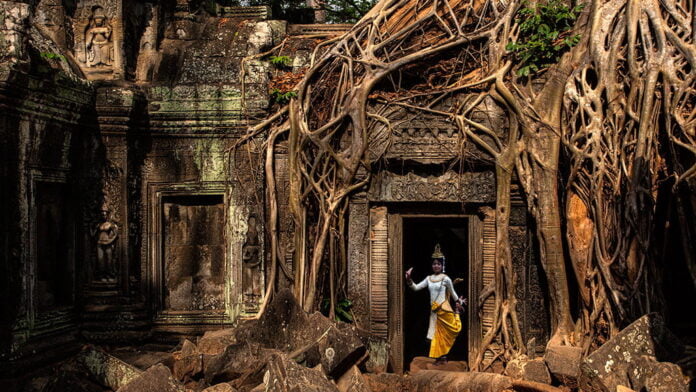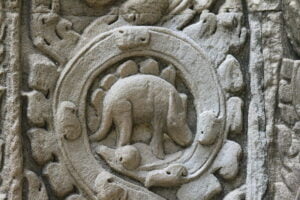When Lara Croft and Tomb Raider pushed Hollywood images of Ta Prohm temple into cinemas around the world in 2001, they consolidated the case for Cambodia as a tourist destination. Little over fifteen years later, millions of visitors flock to Siem Reap each year, many of whom will have their picture taken under “that tree” that Angelina Jolie stood upon during one of the movie’s action scenes.
There is, however, obviously much more to Ta Prohm than its famous friends. It is perhaps included in “the big three” along with Angkor Wat and Angkor Thom as one of the must-see temples because of the movie-attraction, but in reality Ta Prohm is a mesmerizing temple to visit quite apart from its Hollywood status. In fact, it is probably the decision not to clear the site of trees, and leave some of the most impressive jungle/ruin take-overs in place, that caught the attention of film location scouts and made it one of the most atmospheric and most photographed of all the temples.
Location and how to get there
Ta Prohm is part of the small circuit of the Angkor complex and is just a few minutes in a tuk tuk away from Angkor Wat or Angkor Thom. The main buildings of the temple are encircled by a large wall and so are not immediately visible from the road but rather discovered by a short walk on a jungle-lined path. A fantastic way to come to this temple is by bike, through the trails in the Angkor forest and the lesser-used gates. It takes an experienced bike guide to find the route through the crisscross paths but it’s a magical way to explore the area and arrive at the inner enclosures of the temple.
Most visitors combine a tour of Ta Prohm temple with a visit to Angkor Thom and Angkor Wat to fill their one-day pass at the temples. However, Ta Prohm is surrounded by a myriad of other, smaller sites that, combined, can make for a great day of exploration. Banteay Kdei and Ta Nei in particularly are quite under-visited yet interesting sites which make for a peaceful break from the crowds.
Ticket requirements
Ta Prohm is included in the temple pass for the Angkor Archaeological Park. There is no separate entrance fee to visit the temple.
Best time to visit
Ta Prohm temple is best visited early in the morning when everybody else is at Angkor Wat. The surrounding jungle is alive with sounds and the light is at its best for keen photographers trying to catch the ongoing battle between nature and architecture.
History of Ta Prohm temple
Ta Prohm’s original name was Rajavihara, meaning “monastery of the King”. It was built as a Mahayana Buddhist monastery and university. The construction of the temple is dated to 1186AD, but it is generally considered to have been added to and embellished over a period of several years. As Maurice Glaize comments in his appraisal of the temple, “While for some time all the various temples in the style of the Bayon were attributed to a single king – Jayavarman VII – during his twenty or so years reign, today it seems more likely that he could not, in such a short time, have done more than just transform, extend or complete already existing religious establishments with his mark.”
Jayavarman VII dedicated Ta Prohm to his family, as evidence by the inscriptions on the stele. The inscription lists many of Jayavarman’s ancestors, as well as giving details of the construction enterprise on the site. Perhaps most compelling though is the information the stele gives about the people whose lives revolved around this site. Nearly 80,000 people were involved in serving the temple, coming from over 3,000 surrounding villages. The stele also mentions that there were 102 functioning hospitals in the Kingdom. Numbers like this give a fantastic insight into the sheer scale of the Khmer empire at that time.
Layout and structure
Although work has been done to stabilize the ruins, Ta Prohm was deliberately left much as it was found, giving it the nickname the jungle temple. As a result it can be confusing to navigate the site as some parts are impassable, and it is tempting to explore the temple from one amazing tree formation to the next, rather than by any temple plan.
The layout of the site is relatively simple, consisting of a number of one-story buildings (a “flat” Khmer temple rather than pyramid structure) which are enclosed by a partially-standing rectangular wall 600 x 1000m. Within this wall would have stood a substantial town, but now the temple interior is inhabited by jungle. At the east of the site there are four smaller enclosing walls which wrap around the central sanctuary.
Most people enter the temple from the west, and after a short walk are greeted by a stone terrace in the shape of a cross which forms a walkway over a narrow moat. This leads to the fourth enclosing wall and the beginning of the real Ta Prohm experience. From this point there are courtyards, passageways and towers to explore, all in nature’s grip – partly destroyed and partly conserved by the encroaching jungle. Some of the buildings in the inner enclosures are thought to have been added in later years, such as the libraries in the first and third enclosures. The famous tomb raider tree is located in the central sanctuary and is an impressive sight, the roots seeming to both strangle and support the ruins beneath.
Ta Prohm’s dinosaur carving
Ta Prohm does not feature many complex carvings, or narrative reliefs. In the central sanctuary you can see the holes in the walls that may have held a covering of stucco or metal. Original carvings may have decayed in the jungle, or been destroyed following the death of Jayavarman VII and the rise of Hinduism.
However, visitors may want to try and find the now-famous stegosaurus carving and join the argument as to whether the carving is merely a hoax, or if it does in fact prove that the Khmer civilization had knowledge or even first-hand experience of dinosaurs.





Another super helpful summary, thank you!